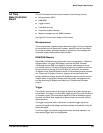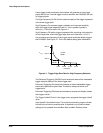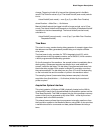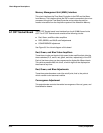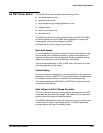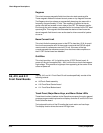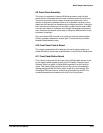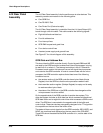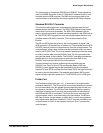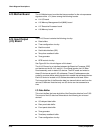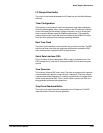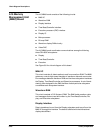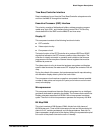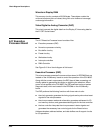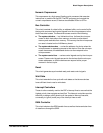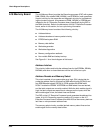
Block Diagram Descriptions
CSA 803C Service Manual
3Ć17
Two other signals of interest are GPIB RQ and GPIB GR. These signals are
used by the DMA Controller on the A17 Executive Processor board to comĆ
municate with the GPIB controller. The DMA can be programmed by the
microprocessor to service either the Inbyte register or the Outbyte register.
Standard RSĆ232ĆC Controller
This communications controller Is connected to the same data bus and
address bus as the GPIB controller. The RPD7ĆRPD0 address lines transfer
data to and from the microprocessor. The RPA1ĆRPA4 address lines are
used by the microprocessor to select individual registers in the GPIB controlĆ
ler. The STD RS SEL line goes low when the microprocessor wants to comĆ
municate with the RSĆ232ĆC controller. (This line also drives the Chip
Enable.)
The RD and WR signals are driven by the microprocessor to signal if the
GPIB controller is to be read from or written into. The controller sets the STD
RS INTR (interrupt) line low to request service from the microprocessor. The
microprocessor writes a byte into the controller's transmit buffer to transmit
data on the RSĆ232ĆC bus. The microprocessor reads a byte from the receivĆ
er buffer to receive data from the RSĆ232ĆC bus. The microprocessor can
also read the status of the controller. The RSĆ232ĆC controller translates the
parallel data from the microprocessor to serial data from RXD on the
RSĆ232ĆC bus to parallel data for the microprocessor.
There are transmit and receive buffers that are compatible with the
RSĆ232ĆC bus. Clear To Send (CTS) and Data Set Ready (DSR) are
RSĆ232ĆC control signals that can be controlled by the microprocessor.
Request To Send (RTS) and Data Terminal Ready (DTR) are signals that can
be read by the microprocessor. The received signal detect (RSD) control
signal is always high when power is on. This RSĆ232ĆC port is a DCE type.
Printer Port
The CentronicsĆstyle printer port, J111, is controlled by a programmable
peripheral interface IC. This IC has all the control lines necessary to connect
to a microprocessor, plus two general purpose eightĆbit ports and the conĆ
trol signals to use them. The A12 Rear Panel Assembly Data bus and AdĆ
dress bus connect to the IC and have the same function as described for
the GPIB and RSĆ232ĆC controllers. The Printer Sel line is set low by the
microprocessor when it is communicating with the interface. The RD and
WR lines allow the microprocessor to either read or write to the registers in
the programmable peripheral interface IC. This IC must be initialized by the
microprocessor for Port A to be a strobed input port. Port C provides the
control signals.



